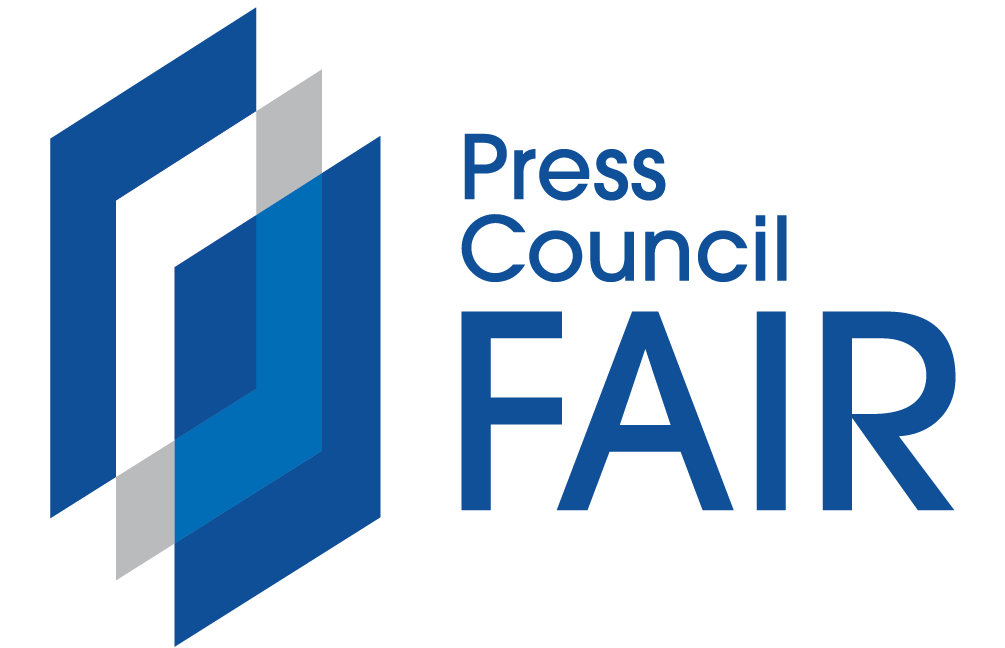Outlier Education
Long drop: How many SA schools still lack proper toilets?
📝 By Laura Grant
At the end of last year, the new Minister of Basic Education Siviwe Gwarube said her department would eradicate all remaining ‘identified’ pit toilets in schools across the country by 31 March 2025. This was her world toilet day promise (yes, world toilet day is a thing).
How close are we to meeting the 31 March 2025 deadline to eradicate pit toilets?
That’s hard to say because it depends on where you look for information.
Let’s start with the Education Facility Management System (EFMS), which is where the Department of Basic Education (DBE) captures information about school infrastructure. It used to be called the National Education Information Management System (Neims). The latest EFMS report, dated 3 June 2024, shows 287 schools in South Africa with basic pit latrines as their only toilets. That’s a big drop from the 7,438 schools dependent on basic pit toilets in the 2014 Neims report.
A back-of-the-envelope calculation shows that over the past 10 years pit toilets have been replaced with appropriate toilets at an average rate of 715 schools a year – or about two schools a day. When you look at it that way, you don’t really get a sense of urgency.
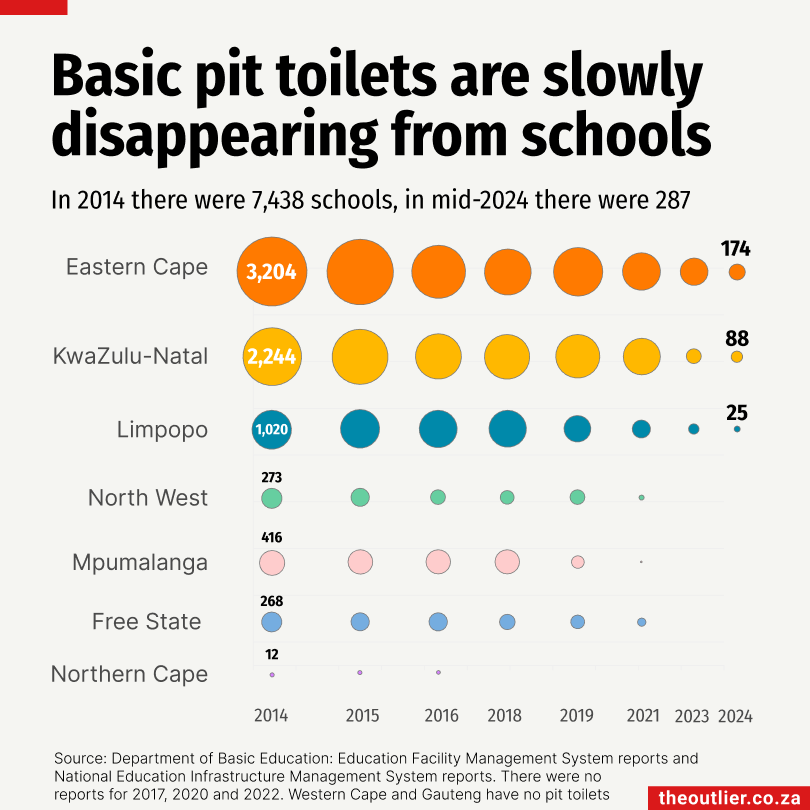
Nevertheless, by 2024 pit toilets were eradicated from schools in all but three provinces, according to the Education Facility Management System data. At the cracking pace of two a day, it should have taken about five months to finish the last 287 schools.
The most recent data we can find, dated 17 February 2025, in a response to a question in parliament, is a list of 171 schools where work was still underway at the beginning of the year. Work at all those schools was expected to be finished by the 31 March deadline, the Department of Basic Education said.
The map below shows where those 171 schools are: five in Limpopo, 56 in KwaZulu-Natal and 110 in the Eastern Cape.
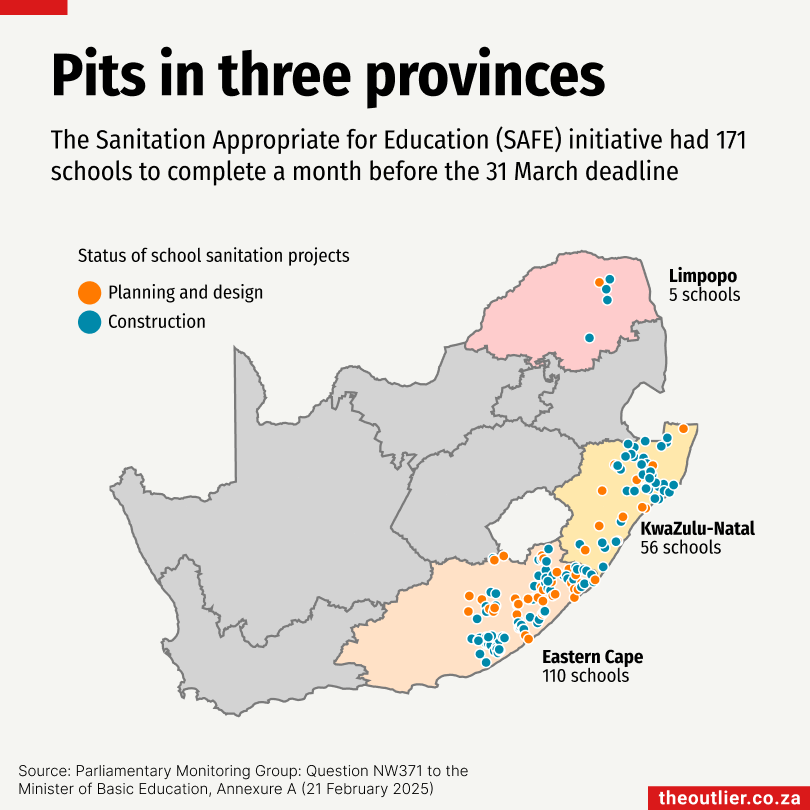
These 171 schools are very likely not all the schools in the country that are reliant on basic pit toilets. They are the ones that fall under the Sanitation Appropriate for Education (SAFE) Initiative.
The initiative was launched in 2018, five months after five-year-old Lumka Mkhethwa, fell into a pit toilet at her school in Bizana, Eastern Cape, and died. We created a data story about this at the time.
The SAFE initiative was meant to speed up the delivery of appropriate sanitation to schools that were dependent on basic pit toilets. At the time there were 1,598 such schools in the Eastern Cape.
Across the country, SAFE had 3,375 schools on its books and by February 2025, the Department of Basic Education said 3,204 of them had received sparkly new toilets. Siviwe Gwarube has been proudly stating that work at 93% of the schools with pit toilets is complete, based on these numbers.
There are many who doubt that the 31 March deadline will be met, even for the schools on the SAFE initiative list. It’s also doubtful whether what is on the SAFE list is a complete list of all the schools that rely on pit toilets in the country.
How reliable are the numbers?
Let’s use Limpopo as an example.
SECTION27 has been monitoring the Limpopo Department of Education’s (LDoE’s) progress in eradicating pit toilets and fixing other sanitation problems at schools in the province since December 2021.
Every six months since December 2021, the Limpopo education department reports to the High Court in Polokwane on the progr ess being made to fix the sanitation in schools because of a court order handed down in the Michael Komape case. Michael died after falling into a pit toilet at his school in Limpopo in 2014. He was five years old.
On behalf of SECTION27 we’ve turned these batches of updates (they’re scans of PDFs of spreadsheets) back into spreadsheets (there have been six batches so far), put them in a database and built a searchable table and a map that allows anyone to search for a school, see what its sanitation facilities were in 2021 and follow its progress over the past three years. It’s named the Michael Komape Sanitation Progress Monitor to honour the child who died.

The Limpopo education department divided the province’s schools into three categories based on the state of their sanitation, after conducting an audit. Priority 1 schools had inappropriate sanitation, ie. they had pit toilets only and needed the most urgent attention. Priority 2 schools had inadequate sanitation, eg, not enough appropriate toilets for the number of learners at the school and maybe some basic pit toilets, and Priority 3 schools, which had compliant sanitation but in need of refurbishment and maybe also some pit toilets that needed to be removed.
The Priority 1 schools need to be fixed by 31 March 2025
If the data made available about Limpopo’s schools is an indicator of the data available for other provinces, then the minister has her work cut out for her in fulfilling her promise to eradicate the pit toilets in all schools.
More than 500 Limpopo schools changed priority category over the three-year period. Twenty-six of the original Priority 1 schools were moved to another priority and nearly 250 schools were moved into Priority 1 from the other two priority categories. As a result, keeping track of the schools that have pit toilets only in Limpopo is not as easy as you’d think.
Then there are the schools that have been listed as ‘to be closed’. There are close to 90 of them and some appear to be in a kind of limbo where nothing is being done to improve their sanitation. It’s hard to tell from the information being provided by the Limpopo Department of Education. Some of them have been listed as ‘to be closed’ for three years.
According to the Limpopo Education Department’s latest progress report, which comes in the form of a slide deck, upgrades had been completed at 527 of the 564 Priority 1 schools in the province by June 2024. Only 37 schools remained and they were all expected to be finished by the deadline.
It’s worth noting that the numbers in the department’s slide decks don’t always tally with the data we extract from the other documents submitted, and in 2021 there were originally ~360 Priority 1 schools, not 564. But, at least progress is being made.
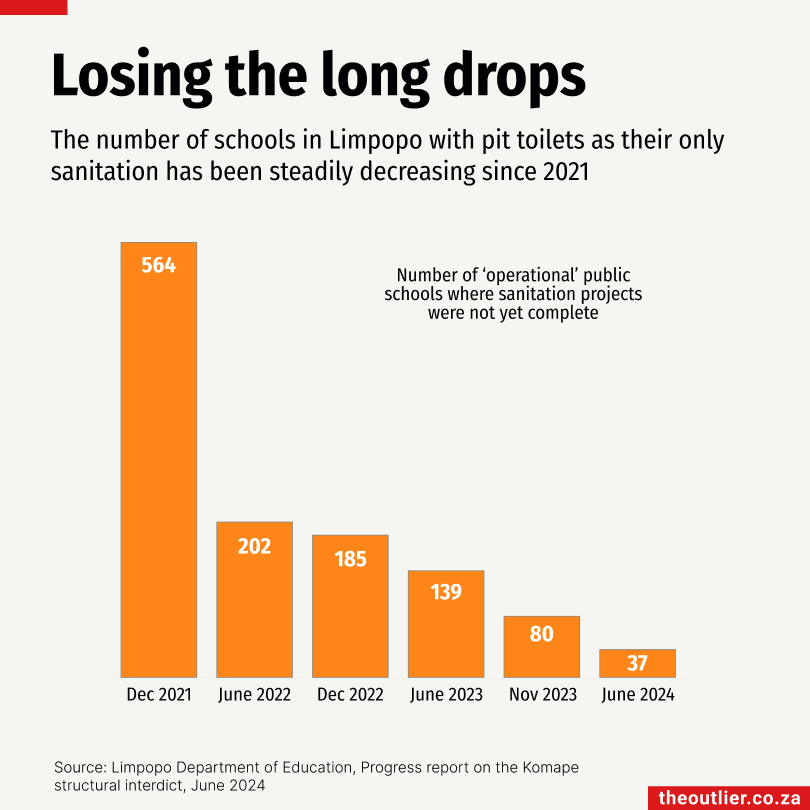
What we did find in the most recent batch of documents is a progress update for November 2024 in which there are 20 Priority 1 schools at which work is still in progress (see map below). There is an interactive version of this map on the Michael Komape Sanitation Progress Monitor that shows all the schools we can find GPS coordinates for.
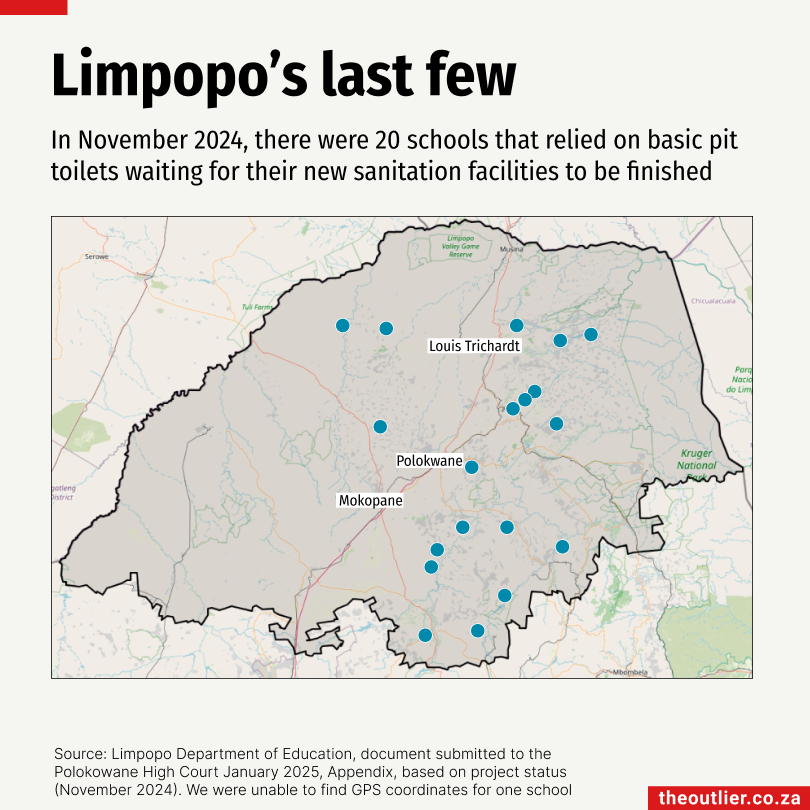
SECTION27 is sceptical about the LDoE meeting the 31 March deadline for the Priority 1 schools. This is not the first deadline the province has missed.
It has done site visits to schools with ‘urgent sanitation needs and immediate safety risks’ where the court order mandated the LDoE to provide mobile toilets while the schools’ permanent toilets are being built.
On a site visit to a school last month, SECTION27 found that 1,000 learners were sharing eight mobile toilets. They become full very quickly and ‘within days, these toilets are maggot-infested, with an unbearable stench and are only cleaned once a week during school hours.’ The construction of the school’s new permanent toilets had not even started, SECTION27 reported.
At another school, four mobile toilets service over 570 learners. ‘As many learners must queue during break time, some accidentally relieve themselves while waiting and must be sent home,’ SECTION27 reports.
Thanks to the Komape case court order, people are able to see what the sanitation status of each of the schools in Limpopo is reported to be by the LDoE. This level of information is almost impossible to find for the other provinces.
SECTION27 commissioned us to build the sanitation monitor to allow the public to access the available information and compare it to their lived experience, to help hold authorities accountable and ensure that unsafe and undignified sanitation is removed from our schools.
This is a case where good data could save a child’s life.
Most-popular school subjects, ranked

What subjects are South Africa’s high school learners opting to take to grade 12? English, maths literacy and life sciences are the three most popular choices in terms of the number of learners who wrote the final grade 12 exams.
Of the 11 ‘core’ subjects offered (see chart) in SA’s school’s, maths is ranked fifth and physical science eighth.
In 2024, close to 584,000 learners wrote English, 443,000 wrote maths literacy and 375,000 wrote life sciences.
In comparison, 251,488 wrote maths and 200,715 wrote physical science.
Maths and physical science are what the department of basic education calls ‘gateway subjects that are essential for South Africa’s socioeconomic development’, yet only about one-third (36%) of the grade 12 learners wrote the maths exams and 28% wrote the physical science exams.
In both subjects, about one in five passed with 60% or more, the marks required to get into a science degree at university.
🔗 Read more: Matric 2024 Results: Our Highlights
Matric 2024 results: Our highlights
By Laura Grant
A lot has been written about the 2024 matric exam results so rather than rehashing the same information I looked through the results to see what ‘sparks of joy’ I could find other than the overall pass rate of 87.2%
Bachelor passes
Take the number of bachelor passes, for instance. More than 330,000 learners passed their exams well enough to apply to study at a university. What that means is nearly half of 2024’s grade 12s (47.8%) got the highest-level pass, aka, a bachelor pass.
Girls are steaming ahead of boys with 49.2% of them earning bachelor passes.
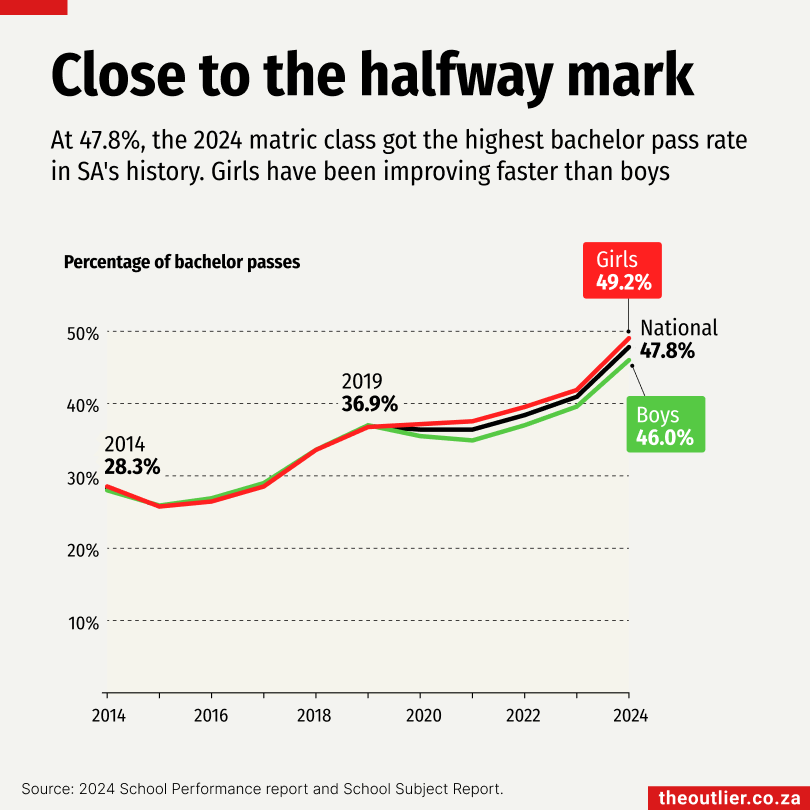
Girls have outnumbered boys in grade 12 classrooms for at least the past four years. Since 2021 about 56% of learners were girls, so it’s little wonder that more girls earned bachelor passes in 2024 than boys – 51,000 more, if you want put a number on it.
Education experts have expressed concern about the disparity in numbers between boys and girls in grade 12 because it’s a sign that boys may be struggling in the education system.
More girls than boys
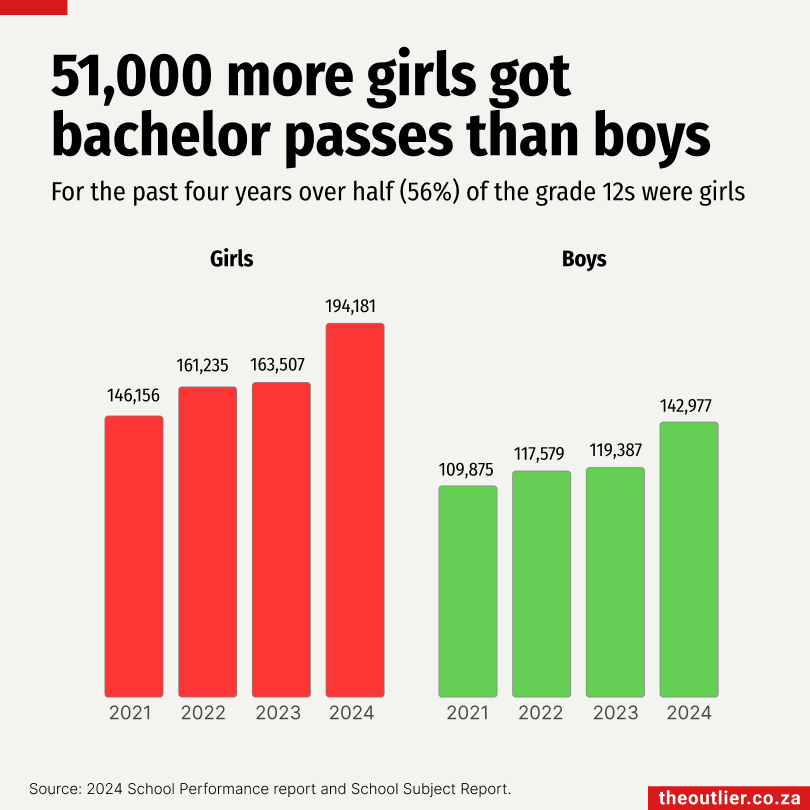
To quote our new minister of basic education, Siviwe Gwarube, “The National Senior Certificate is not just a certificate – it is a gateway to opportunities that empower our young people to pursue further education, enter the workforce and contribute to the socio-economic development of South Africa.“
A recent StatsSA earnings report shows that a tertiary education can have a big influence on the money a person earns.
There are, no doubt, still many anxious young women and men waiting to hear if they have a place at a university this year.
My second spark of joy is from the increase in the number of learners who passed maths with 60% or more in 2024. This is a requirement for anyone wanting to do a science, engineering or technology degree.

The government set a target of 35,000 people getting 60% for maths a year by 2024. The 2023 matrics were the first group to exceed that target and the class of 2024 has done even better.
The same target was set for physical science, but things took a turn for the worse there in 2024.
Spark of joy three came from digging around in the school subject report the Department of Basic Education publishes. This lists every school, how many learners wrote the matric exams, how many wrote maths and how many passed maths, among other things.
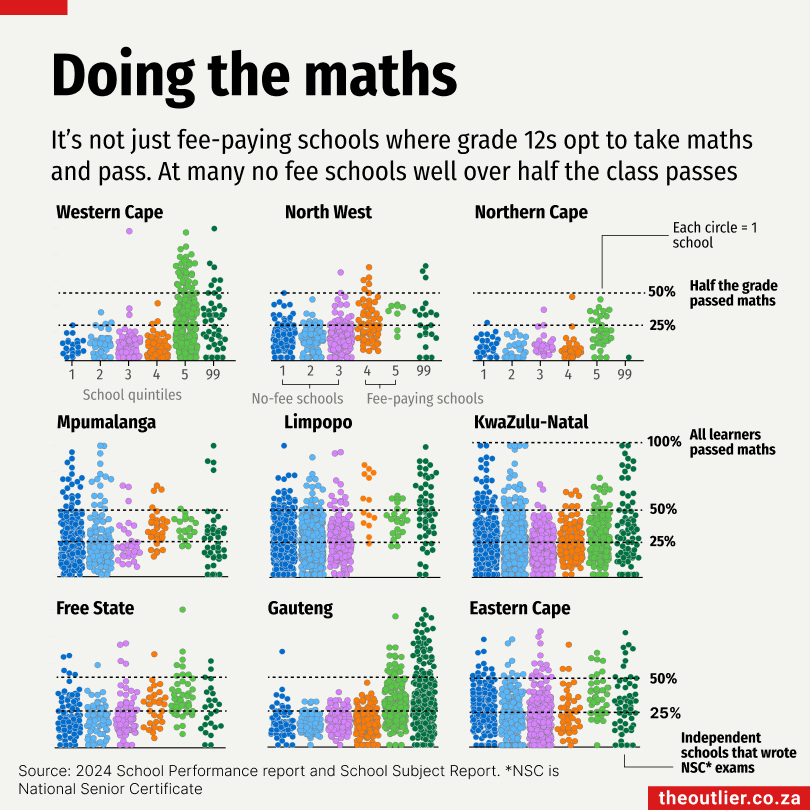
I was interested to see which are the schools where learners wrote the maths exams and, of course, whether they passed. So I worked out what percentage of the total learners at each school wrote maths and passed (with 30% or more because that’s the only information in the report).
The report also lists the quintile of each school. There are five quintiles and they basically represent socioeconomic categories, so schools in quintiles 1 to 3 are usually in lower-income areas and parents don’t have to pay schools fees. Schools in quintiles 4 and 5 tend to be in more affluent areas and parents pay school fees. The schools in the 99 category are generally independent schools where learners wrote the national senior certificate exams.
The quintile 5 schools in the Western Cape stood out. But I suppose that’s what I expected.
What I was really happy to see was how many schools in quintiles 1 to 3 were listed as having children writing and passing the maths exams. A few had 100% of their matrics writing maths and passing. KwaZulu-Natal and Mpumalanga stood out in this regard.
From grade 1 to matric: Tracking the shrinking class of 2024
By Laura Grant

👀 Visit the interactive version of this tracker
Most of 2024’s grade 12 class started their school journey in 2013. In that year, 1.2-million children were enrolled in grade 1. By 2024, the grade 12 class had 740,876 learners – 60% of the size of the class 12 years previously.
In general, the number of children moving to the next grade gradually decreases. After grade 10, there is usually a significant drop. The class of 2024, for example, shrunk by 407,561 learners between grade 10 and matric.
The difference between the number of learners in grade 10 and grade 12 is used to calculate the throughput rate, which was 64.5% in 2024. In other words, close to two out of three grade 10s made it to matric.
This is lower than last year’s 68%. The throughput rate has been decreasing since 2021.
Failure and repetition rates
Mathanzima Mweli, the director-general of the department of basic education, said this year’s 64% throughput rate was ‘healthy’ when compared with other middle-income countries. These, he said, ‘are expected to be around 60% or so’.
The 407,561 who didn’t make it from grade 10 to grade 12 did not necessarily drop out of the education system. ‘Our main problem is the high failure and repetition rate,’ Mweli said when he presented the technical report for the 2024 exams.
The table shows the number of pupils enrolled in each grade from 2007 to 2024, according to department of basic education data.

with The Outlier
• Getting started with spreadsheets
• Learn pivot tables
• Data visualisation tips
• Map-making with data.
Closed book: Three-quarters of schools in South Africa do not have libraries
About 26% of South Africa’s 22,511 schools have libraries, according to data in the Education Facility Management System, published by the Department of Basic Education in July.
Government schools in the Eastern Cape are the worst off, with just 7% of schools having libraries. Only 9% of schools in Limpopo have libraries.
About 69% of schools in the Free State have libraries, the most in the country. Gauteng is the only other province in South Africa where more than two-thirds of the schools have libraries.
In 2013, the department of basic education committed to putting libraries in all government schools by 29 November 2023. The department missed this deadline. In 2024, almost 17,000 schools are still without these facilities.
Of the schools that do have designated library facilities, only 57% (3,312) are actually stocked with books.





